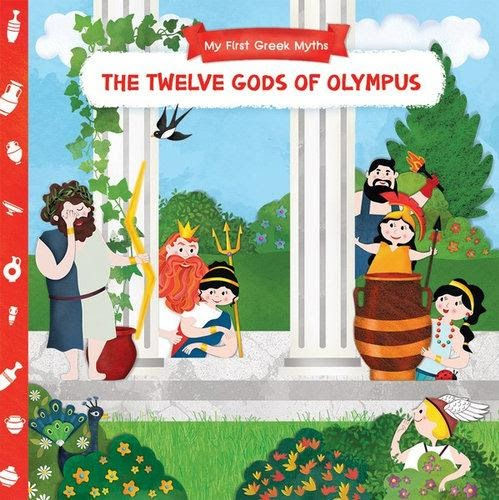Title of the work
Country of the First Edition
Country/countries of popularity
Original Language
First Edition Date
First Edition Details
Anna Gkoutzouri, Οι δώδεκα Θεοί του Ολύμπου [Oi dṓdeka theoí tou Olýmpou], My First Greek Myths [Η μικρή μου μυθολογία (Ī mikrī́ mou mythología)]. Athens: Papadopoulos Publishing, 2019, 10 pp.
ISBN
Genre
Pop-up books
Target Audience
Children
Cover

Courtesy of the publishing.
Author of the Entry:
Charlotte Farrell, University of New England, charlottefarrell@gmail.com
Peer-reviewer of the Entry:
Elizabeth Hale, University of New England, ehale@une.edu.au
Miriam Riverlea, University of New England, mriverlea@gmail.com
The author with her dog Lola. Courtesy of the Author.
Anna Gkoutzouri (Author)
Anna Gkoutzouri is a children's book illustrator, author, designer, and architect based in Greece. She received a Bachelor degree in 2003 in Civil Engineering at the Alexander Technological Educational Institute of Thessaloniki, and a Diploma in Architecture at Aristotle University in 2009. Her background in architecture informs the pop-up elements of her books, as well as her particular interest in how paper engineering can aid and inform young readers' engagement with complex issues. In addition to the "My First Greek Myths" series, Gkoutzouri also published My First Aesop Fables with Faros Books. Both series were originally published in Greek by Papadopoulos Publishing.
Sources:
farosbooks.co.uk (accessed: April 8, 2021),
gr.linkedin.com (accessed: April 8, 2021).
Bio prepared by Charlotte Farrell, University of New England, charlottefarrell@gmail.com
Translation
English: The Twelve Gods of Olympus, Faros Books, 2020, 10 pp.
Summary
The Twelve Gods of Olympus is a board book, a part of Anna Gkoutzouri's charming "My First Greek Myths" series. The book introduces three of the Gods per page and mentions what they were rulers of. Zeus is introduced as the overriding leader of the twelve gods of Olympus. Hera is introduced as his wife. Ares the war god – their son – appears when a lever on the right-hand side of the page is pulled, running after Hera who is waving a white handkerchief in farewell from her horse-drawn chariot, accompanied by a peacock. Olympus is illustrated as rich with wildflowers abundantly rolling over the green hills. Snowcapped mountains in the background are covered in non-deciduous trees of orange, green and brown.
The goddesses Hestia, Demeter, and Athena are introduced. Hestia holds a layered cake atop with candles, with a pot boiling on a little fireplace behind her to symbolize her rulership of the home. A little orange striped cat looks up at Hestia, smiling. Demeter rules the land and lays blissfully on some grass surrounded by blooming wheat, butterflies a platter of fruit, little colourful snails, a pumpkin, and what appears to be a small toy tractor. The inclusion of these playful anachronisms would be recognisable and alluring to the young reader. With the pull of a lever, Athena, goddess of wisdom, is revealed holding a wrapped present and a spear. Next to her is an owl wearing a party hat.
This scene is followed by the introduction of Apollo, Poseidon, and Hermes. The nautical image features Hermes the messenger God flying in the sky with seagulls holding a letter out to Apollo. Apollo, god of Music holds a lyre with a little crab dangling from its strings. Poseidon emerges from the waves holding a trident, the wind flowing in his lustrous red long hair and beard. With a lever, Poseidon can appear or disappear, replaced by a soaring seagull as he dives in and out of the sea. The waves from which he emerges are filled with beautiful, brightly-coloured fish and a sea horse.
The following page pictures Artemis, Aphrodite and Hephaestus. Hephaestus, the fire God, has a bulky frame with a full black beard. He performs metalwork holding a flaming torch and hammer. Goddess of love, Aphrodite, wears jewellery and a long flowing dress. She holds a mirror into which she gazes at herself. Artemis, the huntress, is revealed using a lever where she holds a bow and arrow which she aims at a squirrel juggling apples in an oak tree. There are all sorts of colourful animals in this forest scene: a woodpecker on a tree branch; many birds; and a bunny clutching a carrot.
Analysis
This is a fairly typical example of a general version of the Olympians such as A Greek Mythology Alphabet (Series): Z is for Zeus, focusing on the gods' attributes and powers, without delving into their stories in great depth. As there are no narrative elements to trace in this story, there are not any major narrative aspects at risk of being omitted. Instead, the Gods' powers and attributes are reduced to their purest symbolic form. As a result, the book provides a satisfactorily full picture of the Greek mythological figures by introducing each God and what they were in charge of the ruling. It is a charming introduction to some of the key figures of Greek mythology for a baby reader, where the Olympians are cast as one big happy family. While amicability between the Gods is not entirely accurate, the warm, friendly relationships between the characters make for an engaging and approachable text for the book's intended audience.
The traditional elements associated with the different Olympian gods is expressed playfully and with an eye for detail in this book. Hermes wears his winged helmet and sandals; Poseidon clutches his trident; Apollo holds his lyre. These details connect each of the gods to objects that symbolize them and their powers. They are illustrated in colourful and appealing ways that would delight the baby reader.
Olympus is represented as idyllic in the various scenes, of abundant natural beauty. The Gods appear smiling and friendly. For the baby reader, there are many animals and elements of nature including flowers and trees to point out, name, and/or count. Parents and guardians would likely have more information on the actual myths surrounding the various gods and could use each illustration as a launching point into more storytelling.
Further Reading
Weinlich, Barbara, "The Metanarrative of Picture Books: ‘Reading’ Greek Myth for (and to) Children)", in Lisa Maurice, ed., The Reception of Ancient Greece and Rome in Children’s Literature: Heroes and Eagles, Leiden: Brill, 2015, 85–104.
Weinstein, Amy, Once Upon a Time: Illustrations from Fairytales, Fables, Primers, Pop-ups and Other Children’s Book, Princeton: Princeton Architectural Press, 2005.
Addenda
This entry is based on the English edition (2020).



